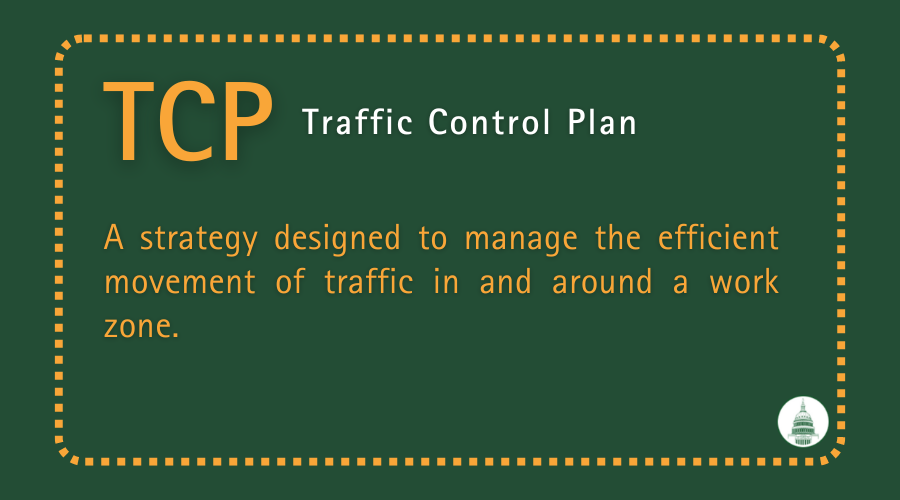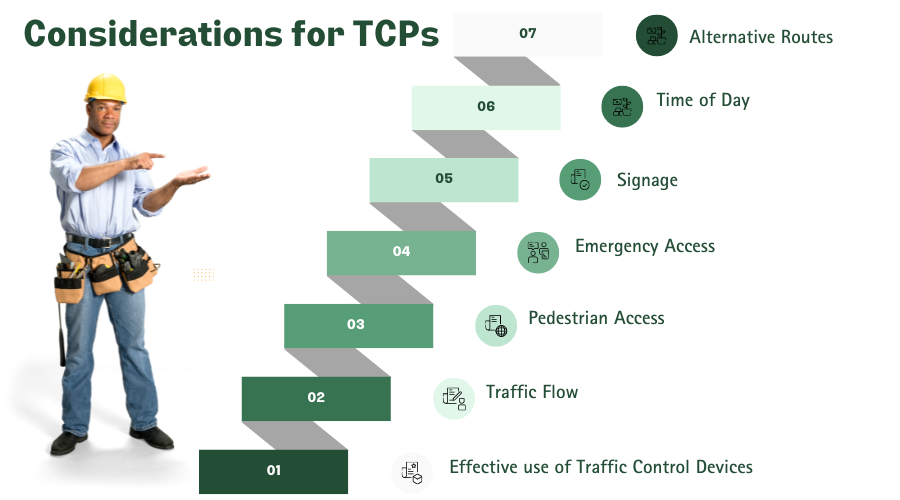Navigating successfully through a construction area is a common issue for many drivers and pedestrians. Here’s where a particular strategy called a traffic control plan, or TCP, becomes essential. Simplifying the essence of a traffic control plan, it’s a blueprint for managing traffic— vehicular, bicycle, and pedestrian— around a construction site. It’s vital for maintaining a smooth and secure flow of traffic, reducing potential hazards, and promoting work efficiency within the work area.
Traffic control plans lean heavily on practicality— ensuring uninterrupted traffic operations while construction work unfolds. We aim to equip you with the knowledge of what exactly a traffic control plan is, its critical components, how to implement one, and the irreplaceable role it plays in work zone safety.

At its core, a traffic control plan is a multi-faceted strategy designed to manage the efficient movement of traffic in and around a work zone. It ensures that the temporary changes to traffic flows—due to road work or construction—and high levels of traffic volume are managed as safely and efficiently as possible.
Fundamentally, a traffic control plan is a blueprint for preventing disruptions in the flow of traffic in these situations. But don’t be misled; it’s not just about the vehicles. The plan also incorporates measures to keep pedestrians and cyclists safe since work zones often involve temporary closures of streets, bike lanes, and even pavements.
Typical traffic control plans go beyond simply dictating the most efficient routes for vehicles and pedestrians. They’re designed to minimize potential hazards to motorists, cyclists, pedestrians, and on-site workers during construction work. It is always about safety first.
A well-designed traffic control plan can help mitigate the risks associated with construction work zones, speed limits, and changes to established traffic patterns. They take into account varying factors like:
To illustrate, let’s take an example of a traffic control plan for a typical street closure due to construction work. First, it should present data for the turning volumes of vehicles at different intersections, peak traffic volume hours, and other vital statistics. Then, it should propose a temporary traffic rerouting scheme which has less impact on the total travel time of road users. It also involves temporary traffic signals function and setting up of additional uniform traffic control devices for directing the flow of traffic.
Knowing your traffic control plan inside out is crucial—not just to manage the flow of traffic but to ensure the safety and efficacy of your work zone. It forms the foundation for smooth transitions and safer work conditions during the inevitable disturbances caused by construction work.

Designing an effective traffic control plan requires keen attention to detail. The plan should address a variety of situations that occur in different stages of construction. Here are the crucial components you need to consider for a robust traffic control plan.
The backbone of any traffic control plan is the uniform traffic control devices. It includes procuring and outlining various signage, road markings, and installations that guide and regulate road users’ operations. Ensuring they are implemented correctly helps maintain consistency across all phases of construction, notwithstanding the changing conditions.
In a typical scenario of work zones, lane or street closures are inevitable. The traffic control plan should lay out detailed procedures for dealing with closures, ensuring they cause minimal disruption and confusion among road users.
Every phase of construction brings different conditions and introduces new challenges to the flow of traffic. A comprehensive traffic control plan anticipates these changes and includes strategy adaptations for each construction phase.
A well-thought-out traffic control plan always factors in the safety requirements of a construction work zone. The risk factors in the work zone, like moving equipment, material stacks, and workers’ movement, need to be considered. In compliance with local safety parameters, suitable traffic control devices and clear signage can help reduce the onset of potential hazards.
Effective traffic management is about accommodating all road users, including motorists, cyclists, and pedestrians. In many cases, temporary provisions like alternative pathways and clear signage must be incorporated for pedestrians and cyclists, keeping their safety in consideration throughout the construction period.
Remember, a traffic control plan is not about copying and pasting standard procedures. It requires meticulous planning, considering various elements, and constantly evolving to meet the site-specific conditions and demands.

Now that you’re familiar with the core components of a traffic control plan, it’s time to understand the process for its efficient implementation.
The first step in implementing your plan requires obtaining a permit from the local governing bodies. Your construction submittal plan must comply with city and state guidelines and meet the various safety and traffic operational standards before getting approval. The depth and detail of your plan can greatly simplify this review and approval process. For more details on construction submittals, read our blog here.
State guidelines often dictate the requirements for a traffic control plan. This could include necessary documentation, schematic representations of design channels, temporary traffic control measures, and much more. Adherence to these guidelines ensures smooth approval and implementation of your plan.
After submitting your plan, it must undergo a detailed review to ensure it meets all the safety and operational standards. This review process involves checking every detail, validating the proposed measures, and ensuring they adhere to the Manual on Uniform Traffic Control Devices (MUTCD). Don’t forget – the proposed plan must be comprehensive yet flexible, able to adapt to evolving scenarios without compromising safety or efficiency.
A successful traffic control plan does not boil down to just rules and regulations. It hugely depends on the timely decisions made during the construction phase. Ensuring that contractors are familiar with and are actively involved in the implementation of the plan can make a considerable difference in achieving the plan’s objectives.
Getting your traffic control plan approved and successfully implemented is a daunting task. It requires specialized knowledge and years of experience dealing with construction projects. That’s when a reliable partner like National Capital Industries is invaluable. With a range of safety and construction products and extensive industry knowledge, we can help ensure your traffic control plan is executed smoothly, keeping your work zone safe and secure.

Assembling a detailed traffic control plan indeed demands time, resources, and specialized product knowledge. But rest assured, you don’t have to go at it alone. National Capital Industries brings decades of experience and is here to provide additional product information that might be crucial in your traffic control plan.
At National Capital Industries, we make safety our priority. Our experience spans over 60 years, supplying essential safety products to numerous customers, Government projects, and associations. With every tool, sign, and piece of equipment you could need to control traffic successfully, we make work zone safety simple and accessible.
Through decades of continuous service, we’ve developed a deep understanding of construction work zone safety, especially in the DMV area. We extensively research, advise, and support you with the best products to help you get your job done right.
Besides crafting a thorough traffic control plan, finding a reliable partner who can provide expert advice, dependable resources, and the right products is equally important. That’s where National Capital Industries comes into the picture.
Reach out to us today, and let’s ensure the safety and efficiency of your work zone together.